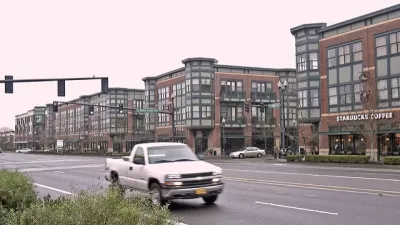Not all density is good, according to the participants at recent event hosted by the Congress for the New Urbanism’s District of Columbia chapter, and examples of new developments cross the line all over the world.

A recent gathering of the Congress for the New Urbanism’s (CNU) District of Columbia featured a discussion of a hot topic in the world of planning: the value of density. According to a dispatch from the event, written by Philip Langdon, most of the participants agreed that not all density is an unequivocal benefit for communities.
Architect and chapter president Dhiru Thadani opened the Council—on ‘Density Without Urbanism/Urbanism Without Density’—by showing rows of high-rise apartment buildings stretching seemingly endlessly across China. ‘People are just being warehoused in large buildings,’ he reflected.
The panel identified examples of “bad” density in the United States, too, in the form of “mid-rise buildings sometimes pejoratively called ‘stumpies.’”
“The typical “stumpy” (the term seems to have originated in the press) consists of five stories of wood-framed apartments sitting atop a concrete podium often containing commercial space or enclosed parking at street level,” explains Langdon.
What’s wrong with stumpies, according to Langdon’s description? “Generally, the buildings lack architectural distinction. The exterior is frequently divided into many vertical segments, sometimes in contrasting materials or colors, in an attempt to make whole thing look less bulky and overwhelming. This fragmented esthetic dismays many city-lovers.”
New Urbanism offers a better middle ground for density, according to participants in the panel—a “goldilocks zone,” if you will. CNU President Mallory Baches pointed to New Urbanist developments for examples, including:
- Del Mar Station in Pasadena, California, with 347 units on 3.4 acres, achieves a density of 102 dwelling units per acre.
- Paseo Verde in North Philadelphia, with 120 units on 1.9 acres, 63.2 units per acre.
- Storrs Center in Connecticut, with 668 units on 47.7 acres, has 14 units per acre.
- Orenco Station in Hillsboro, Oregon, with 2,394 units on 150 acres, has 16 units per acre.
Langdon also recalls Jane Jacobs’ calculation of the ideal density for urban environments, suggesting that “the ideal big-city density is somewhere between 100 and 200 net dwellings per acre.”
There is a lot more to read and ponder about the ideal manifestations of density at the source article linked below.
FULL STORY: When is density good, and when is it harmful to cities?

Planetizen Federal Action Tracker
A weekly monitor of how Trump’s orders and actions are impacting planners and planning in America.

Map: Where Senate Republicans Want to Sell Your Public Lands
For public land advocates, the Senate Republicans’ proposal to sell millions of acres of public land in the West is “the biggest fight of their careers.”

Restaurant Patios Were a Pandemic Win — Why Were They so Hard to Keep?
Social distancing requirements and changes in travel patterns prompted cities to pilot new uses for street and sidewalk space. Then it got complicated.

Platform Pilsner: Vancouver Transit Agency Releases... a Beer?
TransLink will receive a portion of every sale of the four-pack.

Toronto Weighs Cheaper Transit, Parking Hikes for Major Events
Special event rates would take effect during large festivals, sports games and concerts to ‘discourage driving, manage congestion and free up space for transit.”

Berlin to Consider Car-Free Zone Larger Than Manhattan
The area bound by the 22-mile Ringbahn would still allow 12 uses of a private automobile per year per person, and several other exemptions.
Urban Design for Planners 1: Software Tools
This six-course series explores essential urban design concepts using open source software and equips planners with the tools they need to participate fully in the urban design process.
Planning for Universal Design
Learn the tools for implementing Universal Design in planning regulations.
Heyer Gruel & Associates PA
JM Goldson LLC
Custer County Colorado
City of Camden Redevelopment Agency
City of Astoria
Transportation Research & Education Center (TREC) at Portland State University
Camden Redevelopment Agency
City of Claremont
Municipality of Princeton (NJ)





























